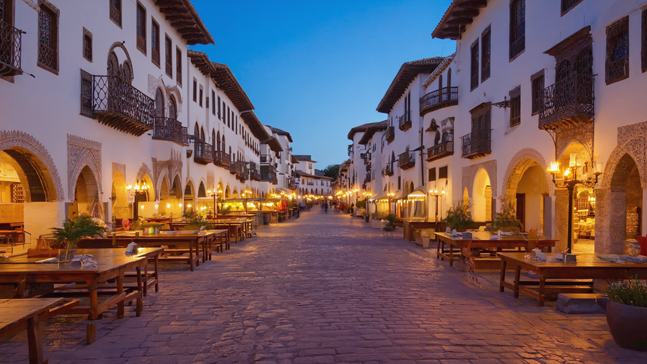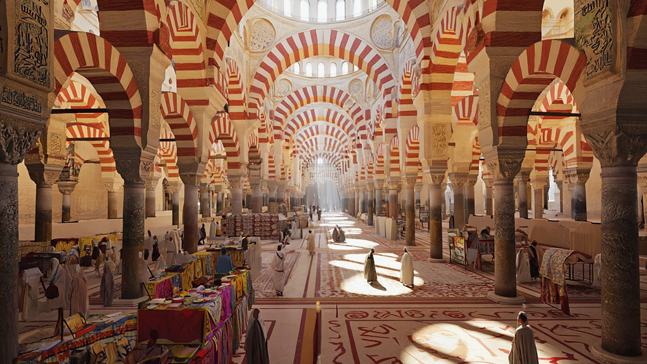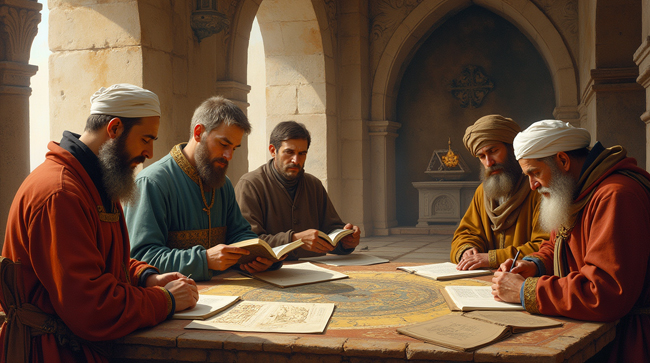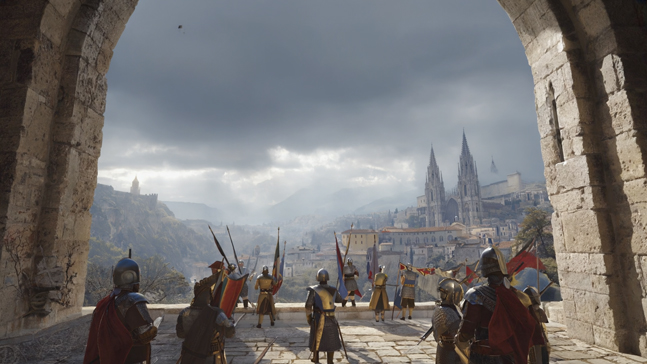When Europe’s Light Came from the South
For nearly eight centuries, a remarkable Islamic civilization flourished in the heart of medieval Europe, creating one of history’s most advanced societies while much of the continent remained in the Dark Ages. Al-Andalus, as Muslim Spain was known, represents one of the most extraordinary chapters in both Islamic history and European heritage.
This comprehensive guide explores the complete Al-Andalus history, from the initial Muslim conquest in 711 CE to the fall of Granada in 1492, revealing how this Islamic empire became a beacon of knowledge, tolerance, and innovation that forever changed the course of world history.
How Muslim Forces Transformed Spain (711 CE)
The Unlikely Victory of Tariq ibn Ziyad
In 711 CE, a relatively small Muslim army of approximately 7,000 soldiers crossed the Strait of Gibraltar under the command of Tariq ibn Ziyad. What happened next defied all military expectations: this modest force defeated the entire Visigothic kingdom that had ruled the Iberian Peninsula for over two centuries.
Key factors in the rapid conquest:
- Local support: Many inhabitants welcomed Muslim rule, tired of oppressive Visigothic governance
- Strategic alliances: Muslims formed partnerships with local Jewish communities and discontented nobles
- Superior military tactics: The invading forces employed advanced cavalry techniques and siege warfare
- Political instability: The Visigothic kingdom was already weakened by internal conflicts and succession disputes
The Establishment of the Umayyad Emirate
Following the initial conquest, Muslim rule consolidated rapidly across the peninsula. By 756 CE, Abd al-Rahman I, a survivor of the Abbasid massacre of the Umayyad dynasty, established an independent emirate in Córdoba, marking the beginning of Al-Andalus as a distinct Islamic state.
When Córdoba Rivaled Baghdad and Constantinople

Urban Development and Infrastructure
At its peak during the 10th century, Córdoba became Europe’s largest and most sophisticated city, boasting:
- Population: Over 500,000 inhabitants (compared to Paris’s 25,000)
- Infrastructure: Paved streets, public lighting, and running water
- Libraries: More than 400,000 manuscripts in public and private collections
- Educational institutions: Dozens of schools, universities, and research centers
The Caliphate of Córdoba (929-1031 CE)
Abd al-Rahman III elevated Al-Andalus to a caliphate in 929 CE, establishing it as one of three major Islamic powers alongside Baghdad and Cairo. This period marked the absolute zenith of Andalusi civilization.
The Islamic Empire’s Knowledge Revolution
Centers of Learning and Translation
Al-Andalus became Europe’s primary conduit for preserving and transmitting classical knowledge. The famous House of Wisdom in Córdoba rivaled its counterpart in Baghdad, serving as a center where scholars:
- Translated Greek, Persian, and Sanskrit texts into Arabic
- Developed new mathematical and astronomical concepts
- Advanced medical knowledge and surgical techniques
- Created innovative agricultural and engineering solutions
Notable Scholars and Their Contributions
Ibn Rushd (Averroes, 1126-1198):
- Reconciled Aristotelian philosophy with Islamic theology
- Influenced European scholasticism for centuries
- His commentaries on Aristotle shaped medieval European thought
Maimonides (1135-1204):
- Jewish philosopher who wrote in Arabic under Muslim rule
- Served as physician to the Almohad ruler
- Bridged Jewish, Islamic, and Christian intellectual traditions
Ibn Arabi (1165-1240):
- Sufi mystic and philosopher
- Developed complex theories of spiritual unity
- His works influenced both Islamic and Christian mysticism
Technological and Agricultural Innovations
Muslim rulers and scholars in Al-Andalus revolutionized Iberian agriculture and technology:
Agricultural advances:
- Advanced irrigation systems (acequia networks)
- Introduction of new crops: rice, cotton, sugarcane, citrus fruits
- Sophisticated crop rotation techniques
- Development of agricultural manuals and treatises
Engineering achievements:
- Complex water management systems
- Advanced architectural techniques
- Improved metallurgy and textile production
- Mathematical applications in construction and design
The Visual Legacy of Al-Andalus

Iconic Monuments That Survive Today
The Great Mosque of Córdoba (Mezquita):
- Begun in 786 CE, expanded over two centuries
- Features distinctive horseshoe arches and striped stonework
- Contains 856 columns creating a “forest” effect
- Now a UNESCO World Heritage Site
The Alhambra Palace Complex, Granada:
- Built primarily in the 13th-14th centuries
- Represents the pinnacle of Andalusi decorative arts
- Features intricate geometric patterns and Arabic calligraphy
- Combines residential, administrative, and defensive functions
The Giralda Tower, Seville:
- Originally built as a minaret for the Great Mosque
- Later converted to a cathedral bell tower
- Demonstrates architectural continuity between Islamic and Christian periods
Artistic Innovations and Influences
Andalusi artists developed distinctive styles that blended:
- Islamic geometric patterns
- Byzantine decorative techniques
- Local Iberian craftsmanship traditions
- North African artistic influences
Interfaith Coexistence in Medieval Spain (Convivencia)
Understanding Religious Plurality in Al-Andalus

The concept of convivencia (coexistence) in Al-Andalus remains one of history’s most debated topics. While not without tensions and limitations, the historical record demonstrates remarkable examples of interfaith cooperation:
Evidence of successful coexistence:
- Jewish communities flourished and reached positions of influence
- Christian communities maintained their religious practices
- Intellectual collaboration across religious boundaries
- Intermarriage and cultural exchange occurred regularly
Limitations and challenges:
- Social hierarchies favored Muslims
- Periodic persecution during less tolerant periods
- Conversion pressures, particularly during Almohad rule
- Economic and social restrictions on non-Muslims
Case Studies in Religious Cooperation
- Jewish poets writing in Arabic: Figures like Samuel ibn Nagrela combined Hebrew religious themes with Arabic literary forms
- Christian scholars in Islamic institutions: Mozarab Christians participated in translation movements and philosophical debates
- Medical collaboration: Physicians of all faiths worked together in hospitals and medical schools
From Unity to Taifa Kingdoms (1031-1086 CE)
The Collapse of Central Authority
The caliphate of Córdoba fragmented in 1031 CE, dividing into numerous small kingdoms called taifas. This period, while politically unstable, produced some of Al-Andalus’s greatest cultural achievements:
- Literary flowering: Poetry and prose reached new heights
- Architectural innovation: Each taifa kingdom competed to build magnificent palaces
- Scientific advancement: Continued despite political fragmentation
- Cultural refinement: Courts became centers of artistic patronage
Major Taifa Kingdoms
Seville (1023-1091):
- Ruled by the Abbadid dynasty
- Known for poetry and literary culture
- Built the Alcázar palace complex
Granada (1013-1090, later 1238-1492):
- Became the last Muslim stronghold
- Constructed the Alhambra
- Maintained independence longest
Toledo (1035-1085):
- Major center of translation and learning
- Fell to Christian forces in 1085
- Continued as a center of cultural exchange
Eight Centuries of Gradual Conquest

Key Phases of Christian Expansion
Early Period (718-1000 CE):
- Christian kingdoms established in northern mountains
- Gradual expansion southward
- Development of Crusading ideology
Great Advances (1000-1248 CE):
- Fall of Toledo (1085)
- Conquest of Córdoba (1236)
- Fall of Seville (1248)
- Only Granada remained under Muslim rule
Final Phase (1248-1492 CE):
- Granada survived as tributary state
- Final conquest by Ferdinand and Isabella
- End of 781 years of Muslim rule in Iberia
Military and Political Factors
The success of the Reconquista resulted from:
- Christian unity: Gradual consolidation of northern kingdoms
- Muslim division: Fragmentation weakened resistance
- Technological changes: Evolution of military tactics and fortification
- International support: Crusading volunteers from across Europe
Be sure to check out our video about this period:
End of an Era (1492 CE)
The Final Campaign
The conquest of Granada by the Catholic Monarchs Ferdinand and Isabella marked the end of Muslim rule in Western Europe. The campaign (1482-1492) featured:
- Systematic siege warfare: Christian forces isolated Granada from outside support
- Internal Muslim conflicts: Civil war within the Nasrid dynasty weakened resistance
- Superior resources: Combined Castilian and Aragonese forces overwhelmed Muslim defenders
- Naval blockade: Prevented North African assistance
The Capitulation Terms
The surrender agreement promised:
- Religious freedom for Muslims
- Protection of property rights
- Continuation of Islamic law for Muslim communities
- Safe passage for those choosing to emigrate
Unfortunately, these terms were largely abandoned within a decade, leading to forced conversions and cultural suppression.
What Happened After 1492?
The Morisco and Mudéjar Communities
After 1492, many Muslims remained in Spain as:
Mudéjares: Muslims living under Christian rule who maintained their religion Moriscos: Forced converts to Christianity who often secretly maintained Islamic practices
These communities faced:
- Increasing persecution and surveillance
- Cultural suppression and forced assimilation
- Final expulsion between 1609-1614
- Loss of centuries-old cultural traditions
Archaeological Discoveries and Modern Research
Recent archaeological work continues to uncover:
- Hidden prayer rooms in houses
- Concealed Arabic manuscripts
- Ceramic and artistic artifacts
- Evidence of continued Islamic practices after 1492
How Al-Andalus Shaped Modern Culture
Linguistic Legacy
Spanish contains over 4,000 words of Arabic origin, including:
- Household items: almohada (pillow), alfombra (carpet)
- Food and agriculture: azúcar (sugar), naranja (orange), arroz (rice)
- Architecture and technology: alcalde (mayor), algoritmo (algorithm)
- Academic terms: algebra, chemistry, alcohol
Cultural Influences
Music and Dance:
- Flamenco incorporates Andalusi musical elements
- Traditional Spanish guitar techniques show Islamic influence
- Rhythmic patterns reflect medieval Iberian fusion
Cuisine:
- Use of spices like saffron and cumin
- Rice-based dishes like paella
- Sweets and pastries with honey and nuts
- Sophisticated use of olive oil
Architecture:
- Mudéjar style blending Islamic and Christian elements
- Decorative tiles and geometric patterns
- Courtyard designs and water features
- Horseshoe arches in Spanish colonial architecture
Scientific and Intellectual Contributions
Al-Andalus preserved and transmitted crucial knowledge:
- Mathematical concepts including algebra and algorithms
- Medical knowledge and surgical techniques
- Astronomical observations and instruments
- Philosophical works that influenced European thought
Frequently Asked Questions About Al-Andalus History
What does “Al-Andalus” mean?
Al-Andalus derives from the Arabic name for the Iberian Peninsula under Muslim rule. The term possibly originates from “Vandalusia,” referring to the Vandals who previously inhabited the region.
How long did Muslim rule last in Spain?
Muslim rule in Spain lasted 781 years, from the initial conquest in 711 CE to the fall of Granada in 1492 CE. However, the extent of territory under Muslim control decreased significantly over this period.
Was Al-Andalus part of a larger Islamic empire?
Initially yes, but Al-Andalus became independent from the Abbasid Caliphate in 756 CE under Abd al-Rahman I, establishing the Umayyad Emirate and later Caliphate of Córdoba.
How advanced was Al-Andalus compared to the rest of Europe?
Al-Andalus was significantly more advanced than most of medieval Europe, featuring urban planning, public infrastructure, extensive libraries, advanced agriculture, and sophisticated intellectual institutions when much of Europe remained largely rural and illiterate.
What happened to the Muslim population after 1492?
Many Muslims emigrated to North Africa, others converted to Christianity (becoming Moriscos), and some maintained secret Islamic practices. The remaining Muslim population was finally expelled from Spain between 1609-1614.
Can you visit Al-Andalus sites today?
Yes, many sites survive as major tourist attractions, including the Alhambra in Granada, the Mezquita in Córdoba, the Alcázar in Seville, and numerous smaller monuments throughout southern Spain.
The Timeless Relevance of Al-Andalus
The history of Al-Andalus offers profound lessons for our modern world. This Islamic empire demonstrated that diverse religious and cultural communities could coexist and collaborate to create extraordinary achievements in science, philosophy, arts, and governance.
From the mathematical concepts we use daily to the words we speak, from architectural styles to culinary traditions, the legacy of Muslim Spain continues to enrich our lives eight centuries after its political end.
Understanding Al-Andalus history helps us appreciate the complex, interconnected nature of human civilization and reminds us that knowledge, tolerance, and cultural exchange have always been humanity’s greatest strengths.
Ready to explore more Islamic history?
Subscribe to our newsletter for in-depth articles about the Islamic Golden Age, or explore our comprehensive guides to other great Muslim civilizations throughout history.
